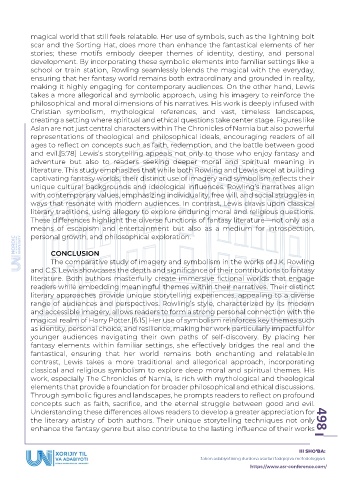Page 500 - Konferensiya to'plami - 1 (ASR)
P. 500
magical world that still feels relatable. Her use of symbols, such as the lightning bolt
scar and the Sorting Hat, does more than enhance the fantastical elements of her
stories; these motifs embody deeper themes of identity, destiny, and personal
development. By incorporating these symbolic elements into familiar settings like a
school or train station, Rowling seamlessly blends the magical with the everyday,
ensuring that her fantasy world remains both extraordinary and grounded in reality,
making it highly engaging for contemporary audiences. On the other hand, Lewis
takes a more allegorical and symbolic approach, using his imagery to reinforce the
philosophical and moral dimensions of his narratives. His work is deeply infused with
Christian symbolism, mythological references, and vast, timeless landscapes,
creating a setting where spiritual and ethical questions take center stage. Figures like
Aslan are not just central characters within The Chronicles of Narnia but also powerful
representations of theological and philosophical ideals, encouraging readers of all
ages to reflect on concepts such as faith, redemption, and the battle between good
and evil.[5:78] Lewis’s storytelling appeals not only to those who enjoy fantasy and
adventure but also to readers seeking deeper moral and spiritual meaning in
literature. This study emphasizes that while both Rowling and Lewis excel at building
captivating fantasy worlds, their distinct use of imagery and symbolism reflects their
unique cultural backgrounds and ideological influences. Rowling’s narratives align
with contemporary values, emphasizing individuality, free will, and social struggles in
ways that resonate with modern audiences. In contrast, Lewis draws upon classical
literary traditions, using allegory to explore enduring moral and religious questions.
These differences highlight the diverse functions of fantasy literature—not only as a
means of escapism and entertainment but also as a medium for introspection,
personal growth, and philosophical exploration.
CONCLUSION
The comparative study of imagery and symbolism in the works of J.K. Rowling
and C.S. Lewis showcases the depth and significance of their contributions to fantasy
literature. Both authors masterfully create immersive fictional worlds that engage
readers while embedding meaningful themes within their narratives. Their distinct
literary approaches provide unique storytelling experiences, appealing to a diverse
range of audiences and perspectives. Rowling’s style, characterized by its modern
and accessible imagery, allows readers to form a strong personal connection with the
magical realm of Harry Potter.[6:15] Her use of symbolism reinforces key themes such
as identity, personal choice, and resilience, making her work particularly impactful for
younger audiences navigating their own paths of self-discovery. By placing her
fantasy elements within familiar settings, she effectively bridges the real and the
fantastical, ensuring that her world remains both enchanting and relatable.In
contrast, Lewis takes a more traditional and allegorical approach, incorporating
classical and religious symbolism to explore deep moral and spiritual themes. His
work, especially The Chronicles of Narnia, is rich with mythological and theological
elements that provide a foundation for broader philosophical and ethical discussions.
Through symbolic figures and landscapes, he prompts readers to reflect on profound
concepts such as faith, sacrifice, and the eternal struggle between good and evil.
Understanding these differences allows readers to develop a greater appreciation for
the literary artistry of both authors. Their unique storytelling techniques not only 498
enhance the fantasy genre but also contribute to the lasting influence of their works
III SHO‘BA:
Jahon adabiyotining durdona asarlari tadqiqi va metodologiyasi
https://www.asr-conference.com/

